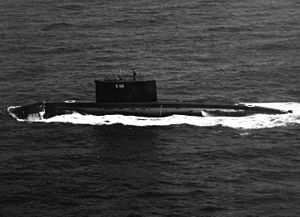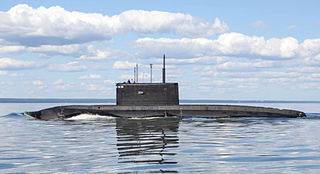
The Kilo-class submarines are a group of diesel-electric attack submarines designed by the Rubin Design Bureau in the Soviet Union in the 1970s and built originally for the Soviet Navy.

INS Sindhurakshak was a Russian-made Kilo-class 877EKM (Sindhughosh-class) diesel-electric submarine of the Indian Navy. Commissioned on 24 December 1997, it was the ninth of the ten Kilo-class submarines in the Indian Navy. On 4 June 2010, the Indian Defence Ministry and Zvezdochka shipyard signed a contract worth US$80 million to upgrade and overhaul the submarine. After the overhaul, it returned to India from Russia between May and June 2013.

The Brahmaputra-class frigates are guided-missile frigates of the Indian Navy, designed and built in India. They are an enhancement of the Godavari class, with a displacement of 3850 tons and a length of 126 metres (413 ft). Although of similar hull and dimension, internally, the Brahmaputra and Godavari classes have different configurations, armaments and capabilities. 3 ships of this class serve in the Indian Navy.

Sindhughosh-class submarines are Kilo-class diesel-electric submarines in active service with the Indian Navy. Their names are in Sanskrit, but in their Roman-alphabet forms sometimes a final short -a is dropped.

The Nilgiri-class frigates were updated versions of the Leander class, designed and built for the Indian Navy by Mazagon Dock Limited in Mumbai. Six ships were built between 1972–81. Vessels of the class formed the 14th Frigate Squadron. The lead ship INS Nilgiri was the first major warship to be built in India and was built in collaboration with Yarrow Shipbuilders of the United Kingdom.
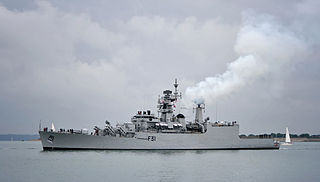
INS Brahmaputra (F31) is the lead ship of her class of guided missile frigates of the Indian Navy. She was built at the Garden Reach Shipbuilders and Engineers (GRSE), Kolkata.
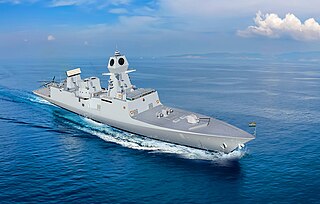
The Nilgiri-class frigates, formally classified as the Project-17 Alpha frigates (P-17A), are a series of stealth guided-missile frigates currently being built by Mazagon Dock Shipbuilders (MDL) and Garden Reach Shipbuilders & Engineers (GRSE) for the Indian Navy (IN).

The Abhay-class corvettes of the Indian Navy are the customised variants of the Soviet Pauk-class corvettes. The class was primarily intended for coastal patrol and anti-submarine warfare. The last ship of the class is expected to be decommissioned by 2025. The class is being replaced by Arnala-class and Mahe-class of Anti-Submarine Warfare Shallow Water Craft. The ships formed the 23 Patrol Vessel Squadron of the Indian Navy.
INS Sindhuraj (S57) is a Sindhughosh-class diesel-electric submarine of the Indian Navy.
UMS Minye Theinkhathu (71) is a Sindhughosh (Kilo)-class submarine owned by the Myanmar Navy. It is the first of two submarines procured by the country's navy, followed by the UMS Minye Kyaw Htin. Before being acquired by Myanmar, it served in the Indian Navy as INS Sindhuvir (S58).
INS Sindhuratna (S59) is a Sindhughosh-class diesel-electric submarine of the Indian Navy.
INS Sindhukesari (S60) is a Sindhughosh-class diesel-electric submarine of the Indian Navy.

INS Sindhukirti (S61) is the seventhSindhughosh-class diesel-electric submarine of the Indian Navy. She was built at the Admiralty Shipyard and Sevmash in the Soviet Union.
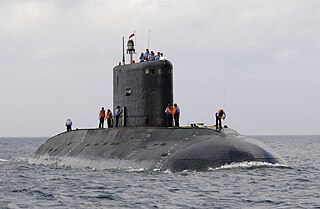
INS Sindhuvijay (S62) is a Sindhughosh-class diesel-electric submarine of the Indian Navy.
INS Sindhushastra (S65) is a Sindhughosh-class diesel-electric submarine of the Indian Navy.

The Kalvari-class submarines, formally classified as the Project-75 submarines (P-75), is a class of diesel-electric attack submarines operated by the Indian Navy. Currently being constructed by a syndicate of French and Indian shipyards, namely, Naval Group and Mazagon Dock Limited (MDL) respectively, the class is an export derivative of the French-origin Scorpène-class submarine, originally designed by Naval Group.

The Visakhapatnam-class destroyers, also classified as the P-15 Bravo class, or simply P-15B, is a class of guided-missile destroyers currently being built for the Indian Navy. The Visakhapatnam class is an upgraded derivative of its predecessor, the Kolkata class, with improved features of stealth, automation and ordnance.

INS Vagsheer (S26) is the sixth submarine of the first batch of six Kalvari-class submarines for the Indian Navy. It is a diesel-electric attack submarine based on the Scorpène class, designed by French naval defence and energy group Naval Group and manufactured by Mazagon Dock Limited, an Indian shipyard in Mumbai, Maharashtra. The ship was launched on 20 April 2022. The submarine is set to be commissioned by December 2024.
